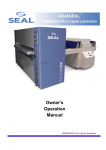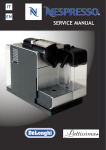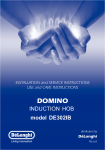Download Caple DOMINO C621 Specifications
Transcript
INSTALLATION and SERVICE INSTRUCTIONS USE and CARE INSTRUCTIONS DOMINO VITROCERAMIC HOB distributed by DèLonghi Pty Ltd Dear Customer, Thank you for having purchased and given your preference to our product. The safety precautions and recommendations reported below are for your own safety and that of others. They will also provide a means by which to make full use of the features offered by your appliance. Please keep this booklet in a safe place. It may be useful in future, either to yourself or to others in the event that doubts should arise relating to its operation. This appliance must be used only for the task it has explicitly been designed for, that is for cooking foodstuffs. Any other form of usage is to be considered as inappropriate and therefore dangerous. The manufacturer declines all responsibility in the event of damage caused by improper, incorrect or illogical use of the appliance or be faulty installation. PRODUCT LABEL This cooktop has been designed and constructed in accordance with the following codes and specifications: 2 AS/NZS 3350-1 General Requirements for Domestic electrical appliances AS/NSZ 3350-2-6 Particular Requirements for Domestic electrical cooking appliances AS/NSZ 1044 Electromagnetic Compatibility Requirements. IMPORTANT PRECAUTIONS AND RECOMMENDATIONS FOR USE OF ELECTRICAL APPLIANCES Use of any electrical appliance implies the necessity to follow a series of fundamental rules. In particular: ■ do not touch the appliance with wet or damp hands or feet ■ do not use the appliance with bare feet ■ this appliance should only be used by responsible adults. IMPORTANT PRECAUTIONS AND RECOMMENDATIONS ■ ■ ■ ■ ■ ■ ■ ■ ■ ■ ■ ■ When unpacking the appliance make sure that it is not damaged. If you have any doubts, do not use the appliance but consult your supplier or an engineer. The packing materials (plastic bags, expanded polystyrene, nails, bands etc.) must not be left within easy reach of children, because they are a possible source of danger. The packaging material is recyclable and is marked with the recycling symbol . Do not try to alter the technical properties of the appliance, because this could be dangerous. The manufacturer cannot be considered responsible for damage caused by improper, incorrect or irresponsible use of the appliance. Before disposing of any unwanted appliances it is recommended that all potentially hazardous parts be made harmless. The appliance should be installed and all the electrical connections made by a qualified engineer in compliance with local regulations in force and following the manufacturer's instructions. During and after use of the cooktop, certain parts will become very hot. Do not touch hot parts. Keep children away from the cooking hob when it is in use. After use, ensure that the knob is in the off position. Some appliances are supplied with a protective film on steel and aluminium parts. This film must be removed before using the hob. Do not carry out cleaning or maintenance operations on the appliance without having previously disconnected it from the electric power supply. TIPS FOR THE USER ■ ■ ■ During and after use of the cooktop, certain parts will become very hot. Do not touch hot parts. Keep children away from the cooking hob when it is in use. Before any cleaning or maintenance, switch off the electricity to the cooktop. 3 INSTALLATION Figure 1 TECHNICAL INFORMATION FOR THE INSTALLER Before installing the cooktop, remove the protective film. This cooktop can be built into a working surface 30 to 40 mm thick and 600 mm deep. ✓ Do not instal the appliance near inflammable materials (eg. curtains). 4 490 + – 20 0 27 Figure 2 50 mm min 750 mm ✓ within the fixture, between the bottom side of the ceramic griddle and the upper surface of any other appliance or internal shelf there must be a clearance of at least 30 mm; ✓ the ceramic hob must be kept no less than 50 mm away from any side wall; ✓ the rear wall must be at least 50 mm from the ceramic griddle and must withstand a temperature of 150°C. ✓ there must be a distance of at least 650 mm between the hob and any wall cupboard or extractor hood positioned immediately above (see fig. 2) ✓ the coatings of the walls of the unit or appliances near the cooktop must be heat resistant. 50 450 mm In order to install the ceramic griddle into the kitchen fixture, a hole with the dimensions shown in fig. 1 has to be made, keeping in consideration the following: 510 288 in mm 50 m 500 mm +02 – Figure 3 FASTENING THE APPLIANCE Each ceramic griddle is supplied with a set of tabs and screws fasten it on units. A A ✓ Cut the unit (as shown in figure 1). A A ✓ Stretch gasket “D” over the edge of the hole made, being careful to overlay the junction edges. ✓ Turn the ceramic griddle over and put tabs “A” into the mountings, only tighten screws “B” a few turns (fig. 4). Make sure that the tabs are mounted correctly as shown in the figures. Turn the tabs so that the cooktop can be put into the hole. ✓ Put the cooktop into the hole cut into the unit and position it correctly. Figure 4 C D ✓ Put tabs “A”; into place, tooth “C” of the tabs should go into the hole (fig. 4). B A 40 mm max. ✓ Using a sharp tool cut off the part of gasket “D” which protrudes from the cooktop. 20 mm min. ✓ Tighten screws “B” until the cooktop is completely secured. 5 ELECTRICAL SECTION ELECTRICAL REQUIREMENTS The appliance must be connected to the mains checking that the voltage corresponds to the value given in the rating plate and that the electrical cable sections can withstand the load specified on the plate. ■ The plug must be connected to an earthed socket in compliance with safety standards. ■ If the appliance is supplied without plug, fit a standard plug which is suitable for the power consumed by the appliance. ■ The wires in the power cable are coloured in accordance with the following code: Green/Yellow = Earth, Blue = Neutral, Brown = Active. If the colours of the wires in the power cable to the appliance do not correspond with the coloured markings identifying the terminals in the junction terminal, proceed as follows: 1.The wire which is coloured green and yellow must be connected to the terminal marked E (Earth) or coloured Green. 2.The wire which is coloured blue must be connected to the terminal marked N (Nuetral) or coloured Black. 3.The wire which is coloured brown must be connected to the terminal marked L (Live) or A (Active) or coloured Red. ■ The appliance must be connected directly to the mains placing a two pole switch with minimum opening between the contacts of 3 mm between the appliance and the mains. ■ The power supply cable must not touch the hot parts and must be positioned so that it does not exceed 50°C above ambient. ■ Once the appliance has been installed, the switch or socket must always be accessible. ■ If the supply cord is damaged it must be replaced by the manufacturer or it’s Service Agent or a similarly qualified person in order to avoid a hazard. ■ N.B. The connection of the appliance to earth is mandatory. If the installation requires alterations to the domestic electrical system call a qualified electrician. He should also check that the socket cable section is suitable for the power drawn by the appliance. 6 Replacing the power cord must be done by a qualified electrician in accordance with the instructions supplied by the manufacturer and in compliance with established electrical regulations. Figure 5 Before carrying out any work on the electrical section of the appliance, it must be disconnected from the mains. REPAIRS A Replacing the supply cable Turn the cooktop over and unhook the terminal board cover by inserting a screwdriver into the two hooks “A”. Open the cable gland by unscrewing screw “F”, unscrew the terminal screws and remove the cable. The new supply cable, of suitable type and section, is connected to the terminal board following the diagrams shown below. Figure 6 F SECTION OF THE SUPPLY CABLE Use H05RR-F cables 230-240 V ~ 50/60 Hz section: 3 x 1,5 mm2 Figure 7 230 V Connection to a good earth wiring system is absolutely essential. The manufacturer accepts no responsibility for any inconvenience caused by failure to comply with this rule. L1 N (L 2) PE 7 ELECTRIC DIAGRAM Figure 8 L N M T P1 1 2 3 4 P2 1 2 3 4 S2 S1 S3 P3 9 P2 5 4 P3 9 P2 5 4 7 P1 3 2 1 7 P1 3 2 1 F1 F2 1131091 ELECTRIC DIAGRAM KEY F1/2 S1 S2/3 P1 P2 M T 8 Switches Line pilot lamp Residual heat pilot lamp Radiant heater 1700W-230V Radiant heater 1200W-230V Terminal block Earth connection VITROCERAMIC HOB Figure 9 SCHOTT 1 2 0 0 1 6 2 3 4 1 5 4 6 6 2 5 3 7 5 4 3 FEATURES - Electrical insulation Class I. GENERAL FEATURES 1. 3 circuits hotplate Ø 180 - 1700 W 2. 3 circuits hotplate Ø 145 - 1200 W CONTROL PANEL DESCRIPTION 3. 4. 5. 6. 7. Hotplate 1 control knob Hotplate 2 control knob Residual heat indicator (Hotplate 1) Residual heat indicator (Hotplate 2) Power indicator light 9 How to use your Ceramic Hob HOW TO USE THE COOKER TOP The main characteristic of this pyroceram cooker top is that it permits rapid vertical transmission of the heat from the heating elements below to the saucepans on top. The heat does not spread horizontally, however, and therefore the glass stays cold only a few centimetres from the hob. 3 circuits radiant hotplate The heating element consists of 3 electrical resistances which can operate together or separately according to the setting of the 7-position switch. It reaches the required temperature very quickly. The cooking plates are shown by dark disks on the ceramic surface. Check that the hob is clean and then switch on by turning the control knob (fig. 9). When the top is working, the pilot light will be on. When the hob temperature is above 60°C, the corresponding indicator light will come on to indicate that the hob is hot. This light will stay on even after the hob has been switched off to indicate that the hob is still hot. The residual heat persists for some time after the hob has been switched off. Figure 10 During this time avoid touching the hob and take particular care if there are children nearby. 0 The light will go out automatically when the hob temperature drops below 60°C. 1 6 2 5 3 10 4 Figure 11 Cooking plate controlled by a 7 position switch Position of switch TYPE OF COOKING 0 Switched OFF 1 2 For melting operations (butter, chocolate). 2 To keep food hot and to heat small quantities of liquid (sauces, eggs). 3 To heat bigger quantities; to whip creams and sauces. (vegetables, fruits, soups). 4 3 4 Slow boiling, i.e.: boiled meats, spaghetti, soups, steam cooking of roasts, stews, potatoes. 5 4 For every kind of frying, cutlets, uncovered cooking, i.e.: risotto. 6 4 5 Browning of meats, roasted potatoes, fried fish, omelettes, and for boiling large quantities of water. 6 Fast frying, grilled steaks, etc. 1 2 3 Heating Cooking Roasting-frying Do not scratch the cooktop with cutting or sharp objects. Do not use the cooktop as a work surface. Caution! the cooking hob becomes very hot during operation. Keep children well out of reach. 11 COOKING HINTS: – To speed up the cooking time, turn the knob to maximum when you switch the cooker top on. Wait a short time and then set the knob to the required cooking position. – Use saucepans with flat bottoms. The bottom of the saucepan should be the same diameter (or slightly larger) as the hob to ensure optimum energy consumption. – As the hob stays hot for a considerable period of time after the cooker top has been switched off, the hob can be switched off a few minutes before the end, leaving the residual heat to complete the cooking. HINTS FOR SAFE USE OF THE HOBS – Before switching on, check which knob controls the required hob. You are advised to place the saucepan on the hob before switching on and to take it off after switching off. – Use saucepans with an even flat bottom (be careful of cast iron saucepans). Uneven bottoms can scratch the pyroceram surface. Check that the bottom is clean and dry. – Check that the saucepan handle does not protrude from the top to avoid knocking it over. This precaution also makes it more difficult for children to reach the saucepan. – Do not use the top if the surface is broken or damaged. If you note a crack in the cooktop, switch the appliance off immediately and call the After-Sales Service. – Do not bend over the hobs when they are on. – Do not leave aluminium foil, greaseproof paper etc. or plastic on the hob when it is hot. Figure 12 – Remember that the hobs stay hot for quite a long time (approx. 30 min.) after they have been switched off. – Scrupulously follow the cleaning instructions. – Do not drop heavy or sharp objects on the glass ceramic cooktop. – Never cook the food directly on the glass ceramic cooktop, but in special pans or containers. 12 Cleaning and Maintenance GENERAL TIPS ■ ■ ■ ■ ■ Before you begin cleaning, you must ensure that the hob is switched off. It is advisable to clean when the appliance is cold, especially when cleaning the enamelled parts. Avoid leaving alcaline or acidic substances (lemon juice, vinegar, etc.) on the surfaces. Avoid using cleaning products with a chlorine or acidic base. Do not use a steam cleaner because the moisture can get into the appliance and make it unsafe. STAINLESS STEEL PARTS ■ ■ Clean with special products which are available on the market. Dry preferably with chamois leather. CONTROL KNOB ■ The control knob may be removed for cleaning but care should be taken not to damage the seal. ENAMELLED PARTS ■ ■ All the enamelled parts must be cleaned with a sponge and soapy water only or other non-abrasive products. Dry preferably with a chamois leather. If acid substances such as lemon juice, tomato conserve, vinegar etc. are left on the enamel for a long time they will etch it, making it opaque. 13 CLEANING THE CERAMIC HOB Make sure that the cooktop is switched off before cleaning it. ■ ■ ■ ■ ■ ■ ■ ■ Remove any encrustation. Remove dust with a damp cloth. Detergents can be used, but they must not be abrasive or corrosive. Any remaining detergent must be completely removed with a damp cloth. Do not put any objects on the cooktop which can melt with heat, such as plastic objects, aluminium foil, sugar or sugar products. If any object melts on the cooktop, remove it immediately (while the cooktop is still hot) using a special scraper, to prevent any irreversible damage to the glass ceramic surface. Do not use knives or sharp objects which could damage the cooktop surface. Do not use abrasive sponges or pads which could irreversibly damage the glass ceramic surface. ATTENTION: MOST IMPORTANT! If cleaning the glass ceramic hob using a special tool (i.e. craper) take extra care to avoid damage to seal the edges of the glass ceramic surface. Figure 13 CAUTION: Any abrasive substances and non-neutral detergents are absolutely not to be used as these can cause permanent damage to these elements. 14 Descriptions and illustrations in this booklet are given as simply indicative. The manufacturer reserves the right, considering the characteristics of the models described here, at any time and without notice, to make eventual necessary modifications for their construction or for commercial needs. 15 cod. 1101940 ß4



























